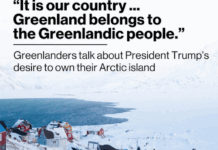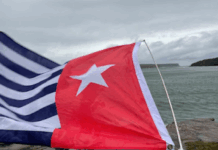
Environmental destruction is not an unintended side effect, but a primary objective in colonial wars of occupation.
By David Whyte and Samira Homerang Saunders
Many in the international community are finally coming to accept that the earth’s ecosystem can no longer bear the weight of military occupation.
Most have reached this inevitable conclusion, clearly articulated in the environmental movement’s latest slogan “No Climate Justice on Occupied Land”, in light of the horrors we have witnessed in Gaza since October 7.
While the correlation between military occupation and climate sustainability may be a recent discovery for those living their lives in relative peace and security, people living under occupation, and thus constant threat of military violence, have always known any guided missile strike or aerial bombardment campaign by an occupying military is not only an attack on those being targeted but also their land’s ability to sustain life.
A recent hearing on “State and Environmental Violence in West Papua” under the jurisdiction of the Rome-based Permanent Peoples’ Tribunal (PPT), for example, heard that Indonesia’s military occupation, spanning more than seven decades, has facilitated a “slow genocide” of the Papuan people through not only political repression and violence, but also the gradual decimation of the forest area — one of the largest and most biodiverse on the planet — that sustains them.
West Papua hosts one of the largest copper and gold mines in the world, is the site of a major BP liquefied natural gas (LNG) facility, and is the fastest-expanding area of palm oil and biofuel plantation in Indonesia.
All of these industries leave ecological dead zones in their wake, and every single one of them is secured by military occupation.
At the PPT hearing, prominent Papuan lawyer Yan Christian Warinussy spoke of the connection between human suffering in West Papua and the exploitation of the region’s natural resources.
Shot and wounded
Just one week later, he was shot and wounded by an unknown assailant. The PPT Secretariat noted that the attack came after the lawyer depicted “the past and current violence committed against the defenceless civil population and the environment in the region”.
What happened to Warinussy reinforced yet again the indivisibility of military occupation and environmental violence.
I’m stand in solidarity with West Papuans rising up against colonialism, racism, state violence, sexual violence, and environmental destruction.
West Papua’s “special autonomy” is another euphemism for control and exploitation ✊🏿🔥 pic.twitter.com/cvP7fp2Ml0
— K.Diallo ☭ (@nyeusi_waasi) May 19, 2021
In total, militaries around the world account for almost 5.5 percent of global greenhouse gas emissions annually — more than the aviation and shipping industries combined.
Our colleagues at Queen Mary University of London recently concluded that emissions from the first 120 days of this latest round of slaughter in Gaza alone were greater than the annual emissions of 26 individual countries; emissions from rebuilding Gaza will be higher than the annual emissions of more than 135 countries, equating them to those of Sweden and Portugal.
But even these shocking statistics fail to shed sufficient light on the deep connection between military violence and environmental violence. War and occupation’s impact on the climate is not merely a side effect or unfortunate consequence.
We must not reduce our analysis of what is going on in Gaza, for example, to a dualism of consequences: the killing of people on one side and the effect on “the environment” on the other.
Inseparable from impact on nature
In reality, the impact on the people is inseparable from the impact on nature. The genocide in Gaza is also an ecocide — as is almost always the case with military campaigns.
In the Vietnam War, the use of toxic chemicals, including Agent Orange, was part of a deliberate strategy to eliminate any capacity for agricultural production, and thus force the people off their land and into “strategic hamlets”.
Forests, used by the Vietcong as cover, were also cut by the US military to reduce the population’s capacity for resistance. The anti-war activist and international lawyer Richard Falk coined the phrase “ecocide” to describe this.
In different ways, this is what all military operations do: they tactically reduce or completely eliminate the capacity of the “enemy” population to live sustainably and to retain autonomy over its own water and food supplies.
Since 2014, the bulldozing of Palestinian homes and other essential infrastructure by the Israeli occupation forces has been complemented by chemical warfare, with herbicides aerially sprayed by the Israeli military destroying entire swaths of arable land in Gaza.
In other words, Gaza has been subjected to an “ecocide” strategy almost identical to the one used in Vietnam since long before October 7.
The occupying military force has been working to reduce, and eventually completely eliminate, the Palestinian population’s capacity to live sustainably in Gaza for many years. Since October 7, it has been waging a war to make Gaza completely unliveable.
50% of Gaza farms wiped out
As researchers at Forensic Architecture have concluded, at least 50 percent of farmland and orchards in Gaza are now completely wiped out. Many ancient olive groves have also been destroyed. Fields of crops have been uprooted using tanks, tractors and other vehicles.
Widespread aerial bombardment reduced the Gaza Strip’s greenhouse production facilities to rubble. All this was done not by mistake, but in a deliberate effort to leave the land unable to sustain life.
The wholesale destruction of the water supply and sanitation facilities and the ongoing threat of starvation across the Gaza Strip are also not unwanted consequences, but deliberate tactics of war. The Israeli military has weaponised food and water access in its unrelenting assault on the population of Gaza.
Of course, none of this is new to Palestinians there, or indeed in the West Bank. Israel has been using these same tactics to sustain its occupation, pressure Palestinians into leaving their lands, and expand its illegal settlement enterprise for many years.
Since October 7, it has merely intensified its efforts. It is now working with unprecedented urgency to eradicate the little capacity the occupied Palestinian territory has left in it to sustain Palestinian life.
Just as is the case with the occupation of Papua, environmental destruction is not an unintended side effect but a primary objective of the Israeli occupation of Palestine. The immediate damage military occupation inflicts on the affected population is never separate from the long-term damage it inflicts on the planet.
For this reason, it would be a mistake to try and separate the genocide from the ecocide in Gaza, or anywhere else for that matter.
Anyone interested in putting an end to human suffering now, and preventing climate catastrophe in the future, should oppose all wars of occupation, and all forms of militarism that help fuel them.
David Whyte is professor of climate justice at Queen Mary University of London and director of the Centre for Climate Crime and Climate Justice. Samira Homerang Saunders is research officer at the Centre for Climate Crime and Climate Justice, Queen Mary University.












































